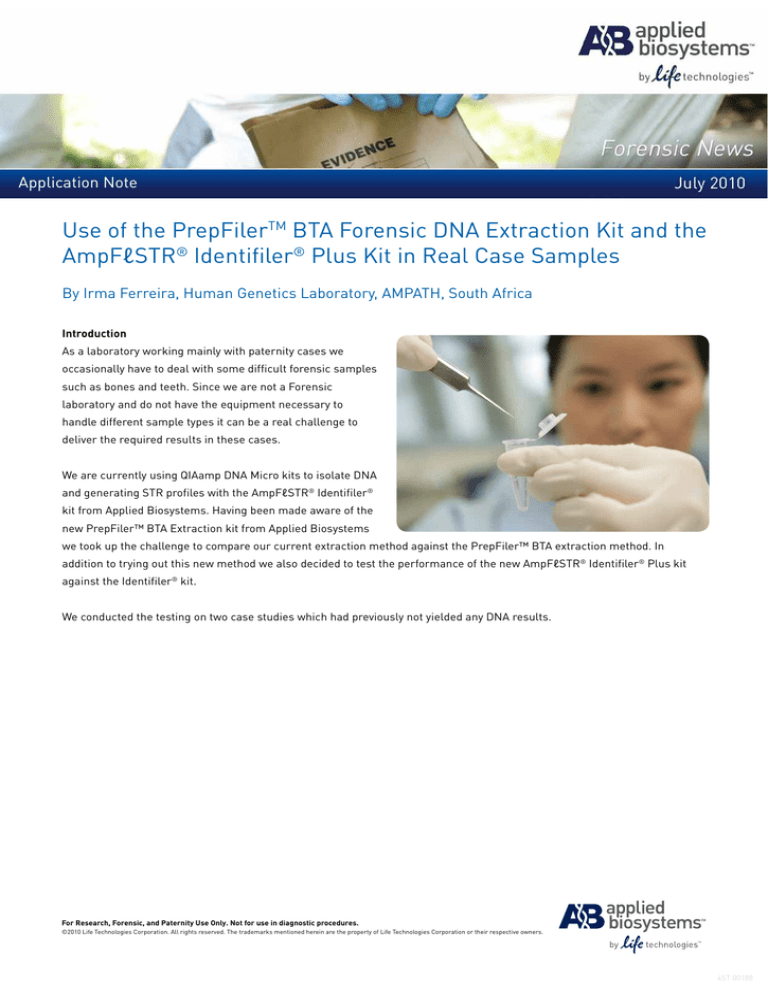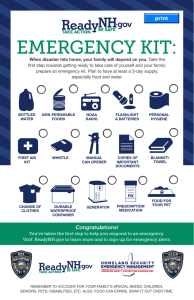
Application Note
Use of the PrepFilerTM BTA Forensic DNA Extraction Kit and the
AmpFℓSTR® Identifiler® Plus Kit in Real Case Samples
By Irma Ferreira, Human Genetics Laboratory, AMPATH, South Africa
Introduction
As a laboratory working mainly with paternity cases we
occasionally have to deal with some difficult forensic samples
such as bones and teeth. Since we are not a Forensic
laboratory and do not have the equipment necessary to
handle different sample types it can be a real challenge to
deliver the required results in these cases.
We are currently using QIAamp DNA Micro kits to isolate DNA
and generating STR profiles with the AmpFℓSTR® Identifiler®
kit from Applied Biosystems. Having been made aware of the
new PrepFiler™ BTA Extraction kit from Applied Biosystems
we took up the challenge to compare our current extraction method against the PrepFiler™ BTA extraction method. In
addition to trying out this new method we also decided to test the performance of the new AmpFℓSTR® Identifiler® Plus kit
against the Identifiler® kit.
We conducted the testing on two case studies which had previously not yielded any DNA results.
For Research, Forensic, and Paternity Use Only. Not for use in diagnostic procedures.
©2010 Life Technologies Corporation. All rights reserved. The trademarks mentioned herein are the property of Life Technologies Corporation or their respective owners.
4ST 00188
Application Note
Case Study One
The first case study was done on a 16 year old bone sample. The body was buried in a shallow sand grave and only a few
bones were left when discovered. The femur was taken, cleaned with bleach and ethanol and left to dry completely. The femur
was sawn in half and the spongy bone inside scraped out with a scalpel and ground to a powder using a pestle and mortar.
50 mg powdered bone sample was then isolated with the QIAamp DNA Micro kit and the PrepFiler™ BTA kit. Both extractions
were performed exactly according to the manufacturers protocol. Currently we do not perform Quantitation of DNA samples
and, thus, had to experiment with various input volumes of DNA extract to get the best possible result. STR amplification was
performed with both the Identifiler® and Identifiler® Plus kits (Fig.1-3).
Figure 1: Bone sample extracted with QIAamp Micro DNA kit and amplified
with the Identifiler® kit. Neither the Identifiler® nor the Identifiler® Plus kits
produced results.
Figure 2: Bone sample extracted with the PrepFiler™ BTA extraction kit and
amplified with the Identifiler® kit. Y scales between 200-400 RFU.
Figure 3: Bone sample extracted with the PrepFiler™ BTA kit and amplified
with the Identifiler® Plus kit. Y scales between 600-1000 RFU.
For Research, Forensic, and Paternity Use Only. Not for use in diagnostic procedures.
©2010 Life Technologies Corporation. All rights reserved. The trademarks mentioned herein are the property of Life Technologies Corporation or their respective owners.
4ST 00188
Application Note
Case Study Two
We received a tooth sample from a burnt, decomposed body which had some bloody tissue attached. The family suspected
the body to be the remains of their missing son and wished to perform paternity testing with the tooth specimen. Roughly
50 mg of powdered tooth was isolated using both extraction methods. The bloody tissue (<25mg) was only isolated using the
PrepFiler™ BTA kit due to a limited amount of sample.
The tooth produced no DNA results with the QIAamp DNA Micro kit but full profiles could be generated with both the
Identifiler® and Identifiler® Plus kit when the DNA was extracted with PrepFiler™ BTA kit (Figures 4 & 5). From the bloody
tissue a partial profile could be generated using the Identifiler® Kit (Figure 6) but a full profile could finally be obtained
following amplification with the Identifiler® Plus kit (Figure 7).
Figure 4: Tooth sample extracted with the PrepFiler™ BTA kit and amplified
with the Identifiler® kit. Note that this is a female profile. Y scales between
500-1000 RFU.
Figure 6: Bloody tissue from tooth extracted with the PrepFiler™ BTA kit and
amplified with the Identifiler® kit. Note: compared to the tooth sample, this a
male DNA profile. Y scales between 200-500 RFU.
Figure 5: Tooth sample extracted with the BTA PrepFiler™ kit and amplified
with the Identifiler® Plus kit. Note that this is a female profile. Y scales between
3000-5000 RFU.
Figure 7: Bloody tissue from tooth extracted with the PrepFiler™ BTA kit and
amplified with the Identifiler® Plus kit. Note: compared to the tooth sample, this
a male DNA profile. Y scales between 1600-3500 RFU.
For Research, Forensic, and Paternity Use Only. Not for use in diagnostic procedures.
©2010 Life Technologies Corporation. All rights reserved. The trademarks mentioned herein are the property of Life Technologies Corporation or their respective owners.
4ST 00188
Application Note
We suspected that the female profile obtained from the tooth sample was due to contamination. It did not match any of the
Laboratory personnel, but we know that the tooth was handled by a family member without the necessary sterile precautions
which could have caused the contamination. A Probability of Paternity was then calculated from the Alleged Father DNA
profile with the male DNA profile from the bloody tissue and the Probability of Paternity was proven at >99.9%.
Conclusion
From the results obtained from the two case studies
mentioned above the new PrepFiler™ BTA extraction kit
for forensic samples, especially developed for samples
such as bones and teeth, performed significantly better
than the QIAamp DNA Micro kit, and the Identifiler® Plus
kit performed better than the current Identifiler® kit. The
Identifiler® Plus kit delivered better amplification of the
larger molecular weight markers, higher overall signal
intensity, cleaner baselines and improved heterozygous peak
height balance.
Previously we were unable to obtain any DNA for these cases, but with the combination of the PrepFiler™ BTA chemistry
and the new AmpFℓSTR® Identifiler® Plus kit from Applied Biosystems we were able to generate full DNA profiles. The
combination of both kits provided a powerful tool for the typing of difficult forensic samples.
For Research, Forensic, and Paternity Use Only. Not for use in diagnostic procedures.
©2010 Life Technologies Corporation. All rights reserved. The trademarks mentioned herein are the property of Life Technologies Corporation or their respective owners.
4ST 00188



